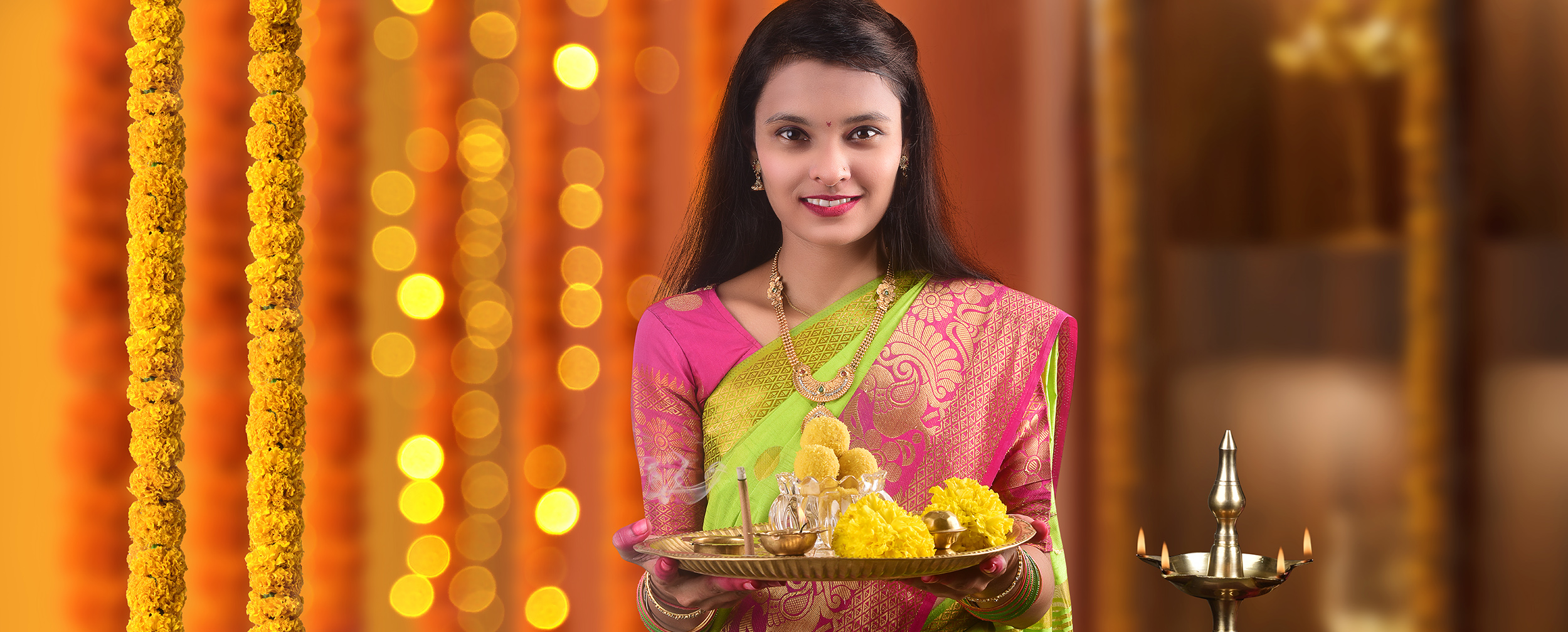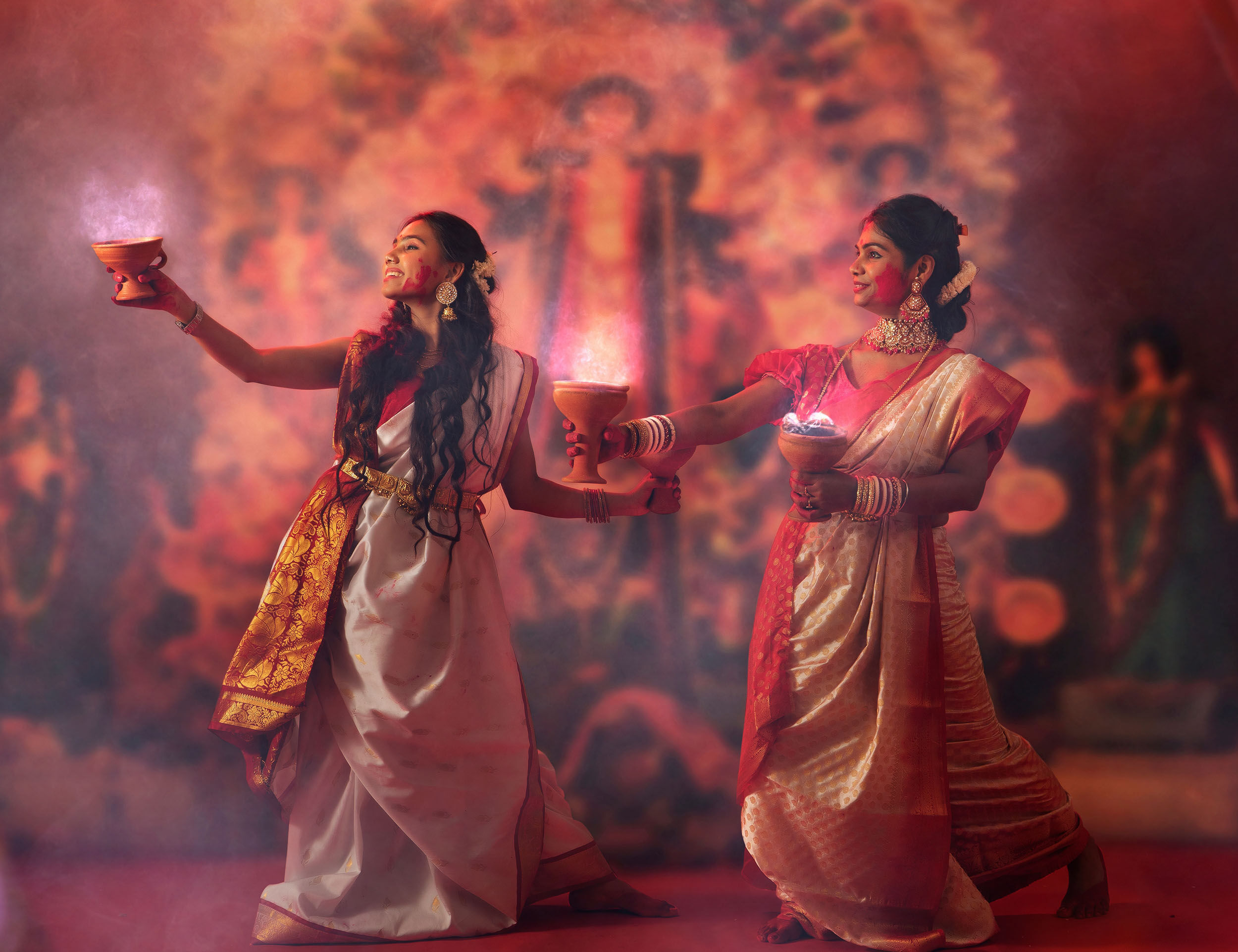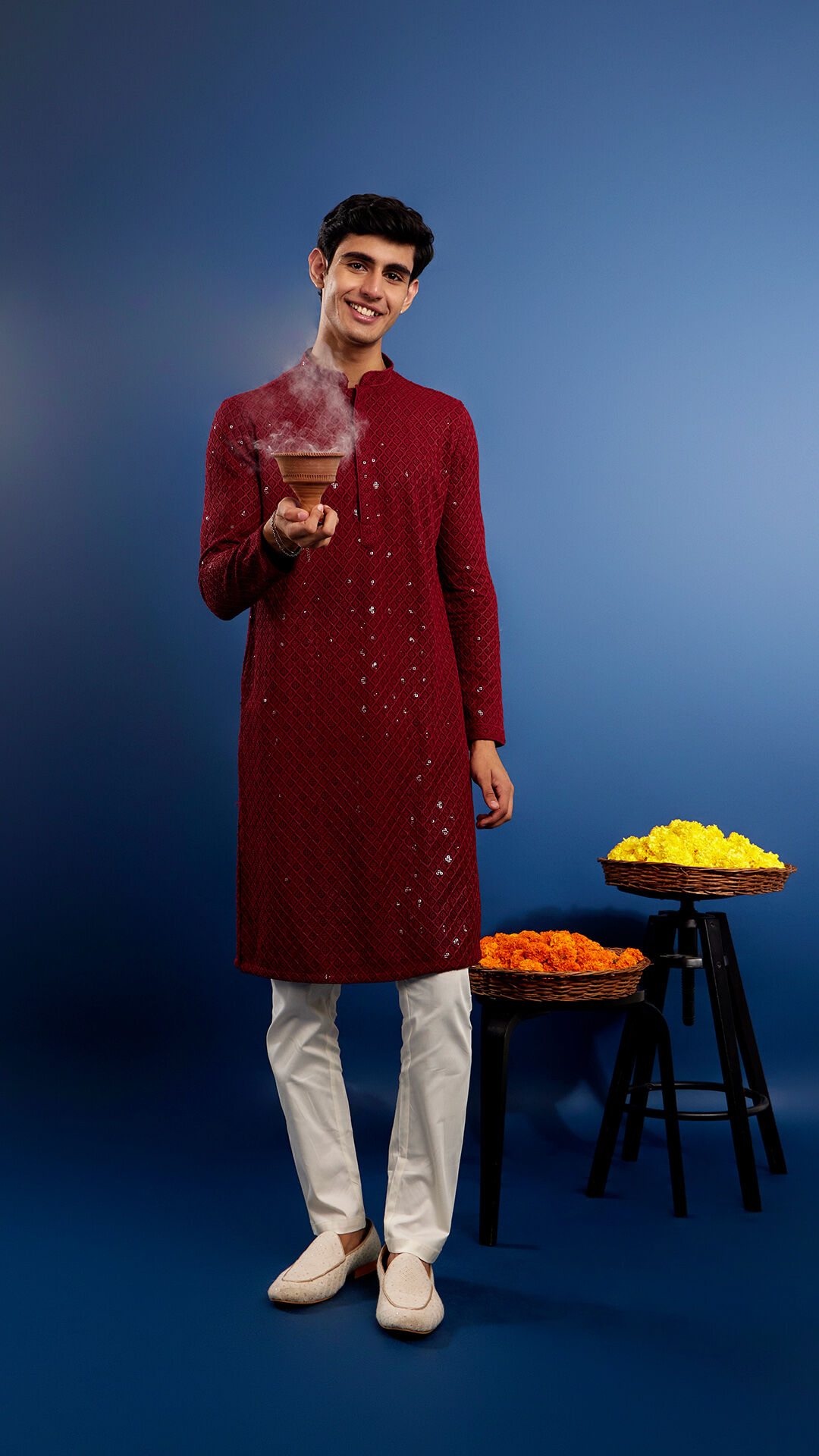STORIES BY DIWAS

Lifestyle
Your Complete Guide to Durga Puja Rituals and Celebrations
Date 9 September 2025 Reading time: 7-10 mins
The conch shell sounds at dawn, marking the arrival of Maa Durga to her earthly abode. The Durga Puja rituals that follow over the next five days transform entire cities into one massive celebration of faith, art, and community spirit.
But what exactly makes these Durga Puja traditions so special? Whether you're participating for the first time or want to deepen your connection with the festival, knowing the significance of Durga Puja helps you appreciate every moment – from the goddess's arrival to her tearful farewell.
Understanding Durga Puja: An Overview
Durga Puja goes far beyond religious observance – it's a cultural phenomenon that brings together art, music, food, fashion, and community in ways that few other festivals can match.
Think of it as Bengal's own version of a grand wedding celebration, where the goddess Durga arrives as a beloved daughter visiting her maternal home. Just like any Indian family preparing for their daughter's visit, devotees spend months planning, decorating, and getting ready to welcome her with all the pomp and ceremony they can muster.
The Importance of Durga Puja
Durga Puja is the cornerstone of Bengali culture, turning neighborhoods into vibrant carnivals of devotion and creativity, far beyond a typical religious festival confined to homes or temples. Economically, it’s a powerhouse, with businesses planning major sales and artisans dedicating the year to crafting intricate idols, decorations, and pandal designs.
The social importance of Durga Puja shines through in how it breaks down barriers. It bridges divides, as pandals welcome everyone regardless of background, and community feasts unite people who rarely connect otherwise, embodying democracy wrapped in festive joy.
The Significance of Durga Puja
The mythological significance of Durga Puja centres on the goddess's victory over Mahishasura, the buffalo demon who terrorised both heaven and earth. This symbolises the eternal victory of good over evil.
Beyond this cosmic battle, her arrival during the autumn harvest signifies prosperity and protection, linking the festival to agricultural abundance and thanksgiving.
Culturally, Durga Puja preserves Bengali arts, from Kumartuli’s clay idols to dhak rhythms, Sanskrit mantras, and traditional dances, while fostering modern creativity.
Durga Puja Rituals: A Detailed Guide
The Durga Puja rituals follow a precise schedule, each with deep symbolic meaning. Understanding these helps you appreciate the spiritual journey that unfolds over the festival days.
Pre-Puja Rituals
The Durga Puja rituals begin long before the main festival days. Mahalaya, occurring seven days before Shashthi, marks the official start of Devi Paksha – the fortnight of the goddess.
Key pre-puja Durga Puja rituals include:
• Kalash Sthapana: Installing a sacred pot filled with water, mango leaves, and a coconut, representing the goddess's presence
• Chokkhudaan: The ritual painting of eyes on the idol, bringing the goddess to life
• Pran Pratishtha: Invoking divine energy into the clay idol through mantras and offerings
Main Puja Rituals
The primary Durga Puja rituals span five incredible days, each with its own ceremonies and significance:
Shashthi (Day 6): Durga Puja begins with Bodhon, awakening the goddess. Priests perform Amantran, inviting Durga to her earthly home with sacred chants.
Saptami (Day 7): The Nabapatrika ritual shines, where nine plants, each symbolising a goddess form, are bathed in the Ganges (or local river) and dressed in a saree as the "Kola Bou" (banana bride), placed beside Ganesha for the festival.
Ashtami (Day 8): The holiest day hosts Sandhi Puja at the precise Ashtami-Navami transition. For 48 minutes, marking Durga’s fierce Chamunda form defeating demons Chanda and Munda, 108 lamps burn as priests chant powerful mantras.
Navami (Day 9): The final worship day features lavish bhog offerings and concluding rituals. Durga Puja hits emotional highs as devotees brace for the goddess’s departure.
Dashami (Day 10): Vijaya Dashami brings bittersweet emotions. Morning starts with Devi Baran, where married women joyfully smear sindoor, celebrating marital bonds. The day ends with Visarjan, the poignant immersion ceremony.
Post-Puja Rituals
The Durga Puja rituals don't end with immersion. Several meaningful customs follow:
• Bijoya Dashami: Younger people touch elders' feet seeking blessings, while elders embrace them, saying "Subho Bijoya"
• Sharing Sweets: Families exchange sweets and greetings, strengthening social bonds
• Shanti Jal: Sprinkling holy water preserved from the rituals to maintain divine blessings
Durga Puja bring communities together, which is witnessed during these post-puja interactions. People visit friends and relatives, rekindling relationships that might have grown distant during the year.
Durga Puja Traditions: A Cultural Insight
The cultural richness of Durga Puja extends far beyond religious ceremonies. These customs create the festival's unique flavour, blending sacred and social elements seamlessly.
Traditional Attire
For women, the white saree with red border remains a timeless pick for married Bengalis. The demand for stylish festive wear kurtas for men peaks during Durga Puja, with contemporary designs offering perfect balance between comfort and celebration-ready style.
Current trends in men's puja fashion include:
• Printed kurtas featuring modern motifs alongside classical designs
• Breathable chikankari kurtas ideal for long pandal-hopping sessions
• Textured kurtas that photograph well for social media moments
• Coordinated kurta and pajamas for men in festive colours
The significance of Durga Puja attire goes beyond looking good – it's about participating in a collective celebration while expressing individual style.
Traditional Food
Food forms the delicious heart of Durga Puja traditions. The bhog (offering to the goddess) becomes prasad (blessed food) shared among devotees, creating community bonds through shared meals.
Essential Durga Puja foods include:
• Khichuri: The signature dish made with rice, lentils, and vegetables, offered to the goddess and served to thousands
• Labra: Mixed vegetable curry cooked without onion or garlic
• Begun Bhaja: Crispy fried eggplant slices
• Luchi-Alur Dom: Deep-fried bread with spiced potato curry
• Payesh: Sweet rice pudding marking special occasions
• Traditional Sweets: Sandesh, rosogolla, mishti doi served after meals
Traditional Music and Dance
The soundtrack of Durga Puja rituals creates an immersive spiritual experience. The dhak, a large barrel-shaped drum, provides the festival's heartbeat. Its rhythmic beats announce the goddess's presence and accompany every major ritual.
Musical Durga Puja traditions include:
• Agomoni Songs: Welcoming songs describing Durga's journey to her maternal home
• Chandipath: Ritual chanting of verses describing the goddess's glory
• Dhunuchi Naach: Dancing with smoking incense pots, creating mesmerising visuals
• Cultural Programs: Evening performances featuring classical, folk, and contemporary arts
Dance forms integral to Durga Puja rituals range from classical Bharatanatyam depicting goddess stories to folk dances like Chhau performed during processions. The spontaneous dancing during Sindoor Khela and Visarjan processions adds joyful energy to solemn moments.
Durga Puja’s Vibrant Legacy
From that first dhak beat to the final splash of Visarjan, Durga Puja rituals weave together faith, art, culture, and community in ways that touch every heart. These Durga Puja traditions, passed down through generations, continue evolving while keeping their essential spirit intact.
As you prepare for this year's celebrations, remember that looking good is part of honouring the occasion. Check out the latest kurtas for men at Diwas and make this Durga Puja memorable with comfort and panache!



